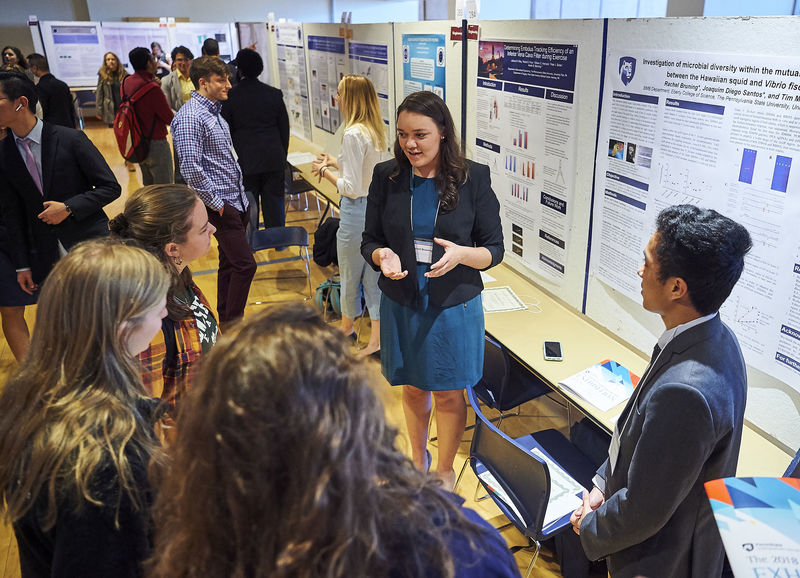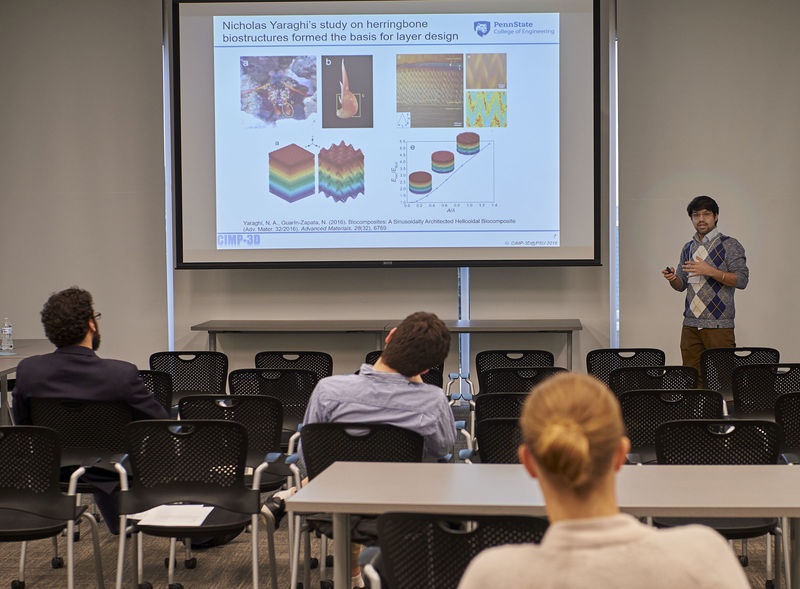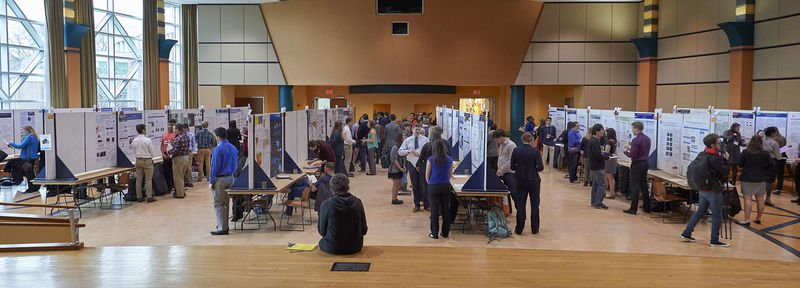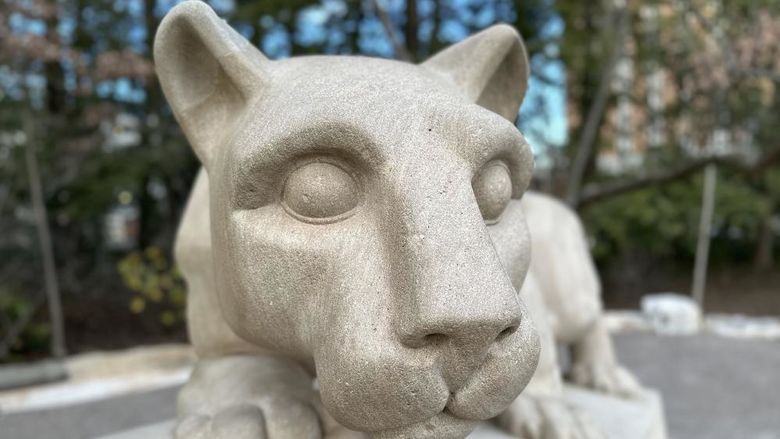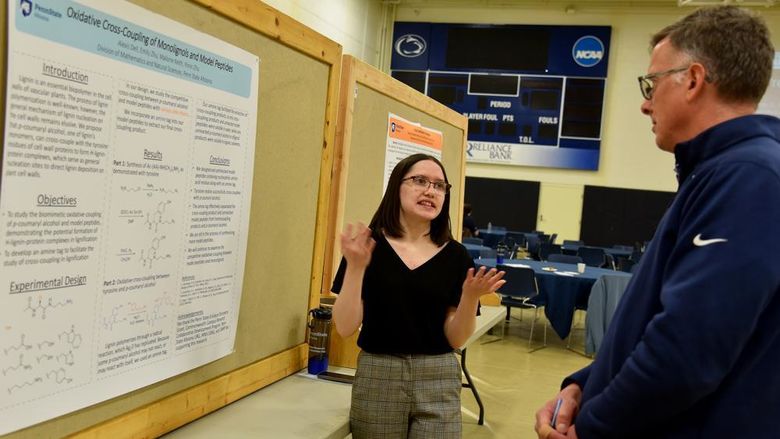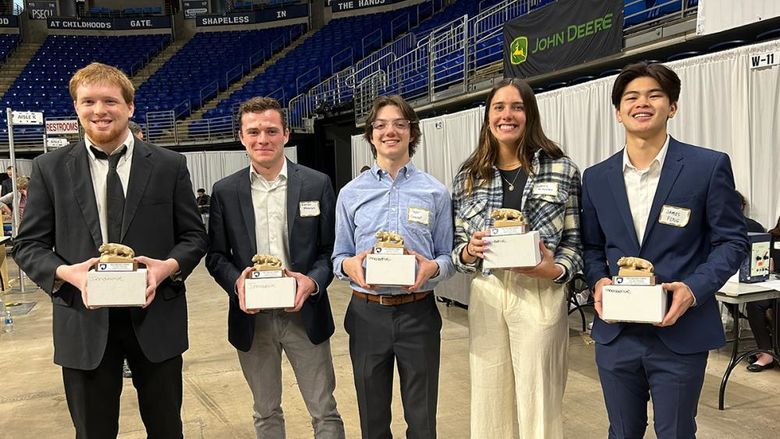
Rachel Bruning, center, explains her research during the 2018 Undergraduate Exhibition.
UNIVERSITY PARK, Pa. — Hundreds of students and judges bustled about in the HUB-Robeson Center Wednesday evening for the 2018 Undergraduate Research Exhibition on the University Park campus of Penn State. From musical presentations in the Flex Theater to posters in Alumni and Heritage halls, the University's best were promoting the fruits of their academic and artistic pursuits.
This was a record year for the exhibition, with more than 340 registered posters and presentations, an increase of more than 100 from last year’s count.
For many undergraduate students, the subjects they condensed to a poster or confine to a short presentation were just a glimpse into years of following a specific subject and many hours of work to pull out results.
It’s also a needed step on the academic path, according to experienced academics such as judge Linnet Brooks. Brooks works for the Hemingway Letters Project, but she has a doctorate in fungal ecology. She said events such as the exhibition help students lay the groundwork for future grant writing to get their work funded, as well as communicate their work to audiences of varying knowledge.
Brooks said that communication to audiences “Can be one of the most nerve-wracking and frightening and anxiety-inducing experiences that you can ever have as researcher. It is an incredibly important part of the learning process, especially if you are going on to a graduate program or if you are considering teaching.”
For some students, this was their first foray into displaying their work. Cecilia Richardsen, a junior majoring in biomedical engineering, explained her poster on “Relationship of Platelet Adhesion with Surface Topography in the Penn State PVAD.”
Communicating to audiences “Can be one of the most nerve-wracking and frightening and anxiety-inducing experiences that you can ever have as researcher. It is an incredibly important part of the learning process, especially if you are going on to a graduate program or if you are considering teaching.”
—Linnet Brooks, exhibition judge
As an aspiring physician, she said she was struck by the lack of pediatric ventricular assist devices to help children’s hearts as they await transplants. At the Artificial Heart and Cardiovascular Fluid Dynamics Lab where she works, she focuses on studying blood clots that form on a PVAD device that is currently being tested.
“So far, the studies have been promising, but a big problem that they've seen is thrombus formation,” she said. “That just means blood clotting. So, this is obviously a problem because as blood is flowing through your body, whenever it clots, your valves are going to get clogged and your heart is not going to be able to pump blood to your entire body.”
She said her research has found there is a relationship between blood clots and the surface roughness of the material being used on the PVAD.
Richardsen’s faculty sponsor was Keefe B. Manning, associate professor in biomedical engineering at Penn State and head of the Artificial Heart and Cardiovascular Fluid Dynamics Lab and associate dean for academic affairs at Schreyer Honors College.
As the evening was drawing to a close, Richardsen said she felt as though the judging portion went well. Each student at the exhibition was judged by one to three different people, all with different bases of knowledge, so students had to adjust the jargon they used.
“It's been good,” Richardsen said of the judging. “I didn't really know what to expect since this is the first time I’ve done this. The judges have all been very engaged. They asked some good questions and overall have been very positive.”
Alan Rieck, assistant vice president and assistant dean for Undergraduate Education, noted that such a large operation couldn’t be pulled off without the help of volunteers and judges.
“It’s amazing to me what undergraduates are capable of doing. It’s also amazing to me what the faculty are doing with their undergraduates. They're giving them an incredible experience.”
—Alan Rieck, assistant vice president and assistant dean for Undergraduate Education
“The volunteers that come and hand out judging forms, that collect scores, that monitor the rooms, we can't do it without them,” Rieck said. “The faculty and doctoral students, and post-docs who do the judging, they’re essential and it doesn't happen without them either. Thanks to everyone, because they made it a great night.”
He said the exhibition is direct evidence of the impressive work being done by students and faculty.
“It’s amazing to me what undergraduates are capable of doing,” Rieck said. “It’s also amazing to me what the faculty are doing with their undergraduates. They're giving them an incredible experience.”
Below is a list of this year’s winners:
Gerard A. Hauser Award
Ethan Liu, Logan Staley, Eberly College of Science — “Exploring the Economic Utilization of Invasive Species to Improve the Select Health of Ecosystems in Cuba,” faculty sponsor Jacqueline McLaughlin
Arts and Humanities
Makaela Bigley, College of Engineering — “Cahal Pech: Recreating Ruins with Structure from Motion Mapping,” faculty sponsor Alexander Klippel
Course-based
1. (Tie) Melissa Mercado, Eberly College of Science — “Bacillus Strains Used as a Biological Control for Trichoderma Aggressivum Aggressivum,” faculty sponsor John Pecchia
1. (Tie) Rachel Crowley, Rachel Gaddis, Christi Geisler, Rachel Gimuriman, Ryan Metz, Smeal College of Business — “DowDuPont Corian Quartz Process Improvement Project,” faculty sponsor David Lenze
Engineering
1. Ashley Castell, College of Engineering — “Advanced Turbine Measurement System Design for Rotating Instrumentation,” faculty sponsor Reid Berdanier
2. Michael Szczesniak, College of Engineering — e Arc Additive Manufacturing (WAAM) Utilizing a Low Cost, Closed Loop Current Control System,” faculty sponsor Guha Manogharan
Health and Life Science
1. Mary Sievers, Eberly College of Science — “Investigating Environmental Factors that Impact Bacterial Antagonism,” faculty sponsor Sarah Ades
2. Amanda Williams, Eberly College of Science — “Investigating Environmental Factors that Impact Bacterial Antagonism,” faculty sponsor Timothy Miyashiro
3. Daniel Ferriss, Sophia Landaeta, Rachel Swope, Eberly College of Science — “Investigating Axonal Neuroprotection and Dendritic Response to Injury in Drosophila Neurons,” faculty sponsor Melissa Rolls
Oral and Performances
1. Rachel Fleischer, College of Arts and Architecture — “Movements from Poema del Pastor Coya by Angel Lasala,” faculty sponsor Naomi Seidman
2. Thomas Wert, College of Arts and Architecture — “Re-envisioning Johnston Square,” faculty sponsor Stephen Mainzer
3. Lucas Tranchita, College of Earth and Mineral Sciences — “Potential Wetland Sites to Reduce Flooding along the Buffalo Bayou in Houston, TX,” faculty sponsor Stephen Mainzer
Physical Sciences
1. Matthew Tracey, Eberly College of Science — “Small Oligonucleotide Models of the Twister Ribozyme Active Site Reveal No Intrinsic Activity of CA and UA Linkages,” faculty sponsor Philip Bevilacqua
2. Jenna Mandel, Eberly College of Science — “Neurons Survive and Regenerate After Injury to Both Axons and Dendrites,” faculty sponsor Melissa Rolls
3. Anna Whitaker, College of Earth and Mineral Sciences — “Gradient Analysis of Upper Ordovician Fossil Assemblages in the Taconic Foreland Basin: Comparison of Central Pennsylvania and Virginia,” faculty sponsor Mark Patzkowsky
Social and Behavioral Sciences
1. (Tie) Alisha Pushinsky, College of Agricultural Sciences — “Determining Zebrafish Preference of Food or Novel Object Presentation Through Behavioral Observations,” faculty sponsor Victoria Braithwaite
1. (Tie) Joseph Sheaffer, College of the Liberal Arts — “Individual Political Ideology Informing the Consumption of Outrage Media,” faculty sponsor Mark Major
3. Rachel Fleischer, College of the Liberal Arts — “Exploring the Passage of Immigration Legislation in the Modern Political Era,” faculty sponsor Michael Nelson
University Fellowships and Phi Kappa Phi Peter T Luckie Awards for Outstanding Juniors
Arts and Humanities
Lindsey Kircher, College of Arts and Architecture — “The Role of Sign and Symbol in Contemporary Painting,” faculty sponsor John Bowman
Sciences and Engineering
Karina Grullon-Perez, Eberly College of Science — “Determining the Role of mthl3 in Dendrite Regeneration,” faculty sponsor Melissa Rolls
Social and Behavioral Sciences
Alexander Rembalsky, College of the Liberal Arts — “The Relationship Between Lesion Recovery and Functional Connectivity in Traumatic Brain Injury,” faculty sponsor Frank Hillary
Library Literacy Awards
Grand Prize
Seamus Wagner, College of the Liberal Arts — “Partisan Bias in Electoral Conflict: Tanzania’s Kawe Constituency,” faculty sponsor Elizabeth Carlson
First place
Emily Seiger, College of Agricultural Sciences — “The Effects of Iron on Mood, Stress, and Quality of Life in Women of Reproductive Age,” faculty sponsor Laura Murray-Kolb
Second place
Sean Clees, College of Engineering — “Vortex Core Dynamics in a Swirling Jet Near Vortex Breakdown,” faculty sponsor Jacqueline O’Connor
Third place
Cristina Frass, College of Arts and Architecture — “Tackling Flooding Issues in Houston,” faculty sponsor Stephen Mainzer
Honorable mentions
Madeline Nyblade, College of Earth and Mineral Sciences — “Numerical Modeling of the Agricultural-Hydrologic System in Punjab,” faculty sponsor Ludmil Zikatanov
Rachel Bruning and Joaquim Santos, Eberly College of Science — “Investigation of Microbial Diversity Within the Mutualistic Symbiosis Between the Hawaiian Squid and Vibrio Fscheri,” faculty sponsor Timothy Miyashiro
Heather Bair, College of Agricultural Sciences — “Reducing Phosphorous Loading in Lake Erie by Identifying Land Areas Suitable for Wetland Construction,” faculty sponsor Stephen Mainzer
Danielle Jones, College of Health and Human Development — “Assessing Physical Activity Promotion Among Church Youth Programs,” faculty sponsor Melissa Bopp
Sarah Mohammed and Matthew Adams, Altoona Campus — “Showcasing Internships: The Art of Scientific Presentations,” faculty sponsor Nick Rowland
The Research Opportunities for Undergraduates program is part of Penn State Undergraduate Education, the academic administrative unit that provides leadership and coordination for University-wide programs and initiatives in support of undergraduate teaching and learning at Penn State. Learn more about Undergraduate Education at undergrad.psu.edu.
